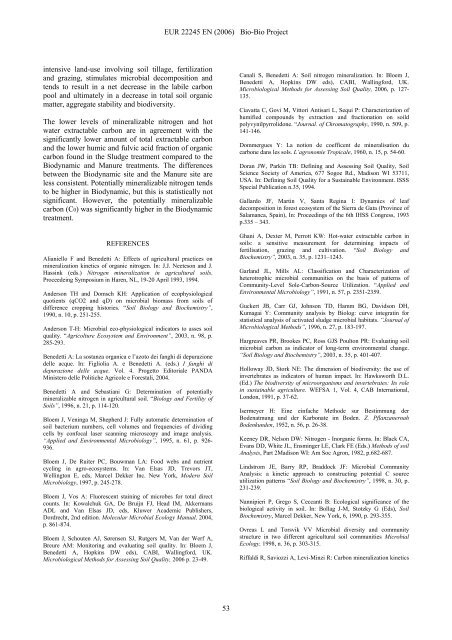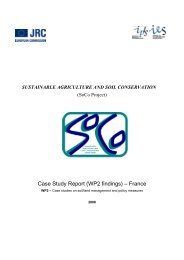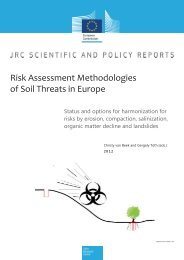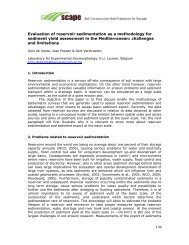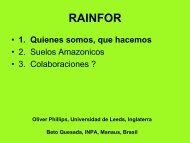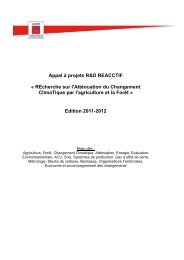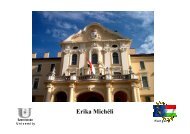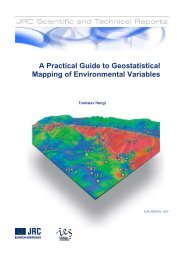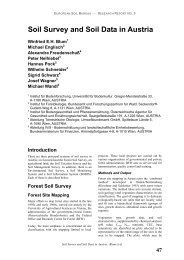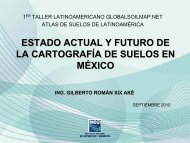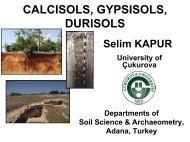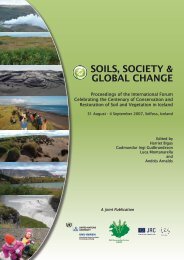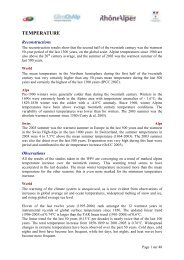Bio - Bio Project - European Soil Portal - Europa
Bio - Bio Project - European Soil Portal - Europa
Bio - Bio Project - European Soil Portal - Europa
You also want an ePaper? Increase the reach of your titles
YUMPU automatically turns print PDFs into web optimized ePapers that Google loves.
intensive land-use involving soil tillage, fertilization<br />
and grazing, stimulates microbial decomposition and<br />
tends to result in a net decrease in the labile carbon<br />
pool and ultimately in a decrease in total soil organic<br />
matter, aggregate stability and biodiversity.<br />
The lower levels of mineralizable nitrogen and hot<br />
water extractable carbon are in agreement with the<br />
significantly lower amount of total extractable carbon<br />
and the lower humic and fulvic acid fraction of organic<br />
carbon found in the Sludge treatment compared to the<br />
<strong>Bio</strong>dynamic and Manure treatments. The differences<br />
between the <strong>Bio</strong>dynamic site and the Manure site are<br />
less consistent. Potentially mineralizable nitrogen tends<br />
to be higher in <strong>Bio</strong>dynamic, but this is statistically not<br />
significant. However, the potentially mineralizable<br />
carbon (C0) was significantly higher in the <strong>Bio</strong>dynamic<br />
treatment.<br />
REFERENCES<br />
Alianiello F and Benedetti A: Effects of agricultural practices on<br />
mineralization kinetics of organic nitrogen. In: J.J. Neeteson and J.<br />
Hassink (eds.) Nitrogen mineralization in agricultural soils.<br />
Proceedeing Symposium in Haren, NL, 19-20 April 1993, 1994.<br />
Anderson TH and Domsch KH: Application of ecophysiological<br />
quotients (qCO2 and qD) on microbial biomass from soils of<br />
difference cropping histories. “<strong>Soil</strong> <strong>Bio</strong>logy and <strong>Bio</strong>chemistry”,<br />
1990, n. 10, p. 251-255.<br />
Anderson T-H: Microbial eco-physiological indicators to asses soil<br />
quality. “Agricolture Ecosystem and Environment”, 2003, n. 98, p.<br />
285-293.<br />
Benedetti A: La sostanza organica e l’azoto dei fanghi di depurazione<br />
delle acque. In: Figliolia A. e Benedetti A. (eds.) I fanghi di<br />
depurazione delle acque. Vol. 4. Progetto Editoriale PANDA<br />
Ministero delle Politiche Agricole e Forestali, 2004.<br />
Benedetti A and Sebastiani G: Determination of potentially<br />
mineralizable nitrogen in agricultural soil. “<strong>Bio</strong>logy and Fertility of<br />
<strong>Soil</strong>s”, 1996, n. 21, p. 114-120.<br />
Bloem J, Veninga M, Shepherd J: Fully automatic determination of<br />
soil bacterium numbers, cell volumes and frequencies of dividing<br />
cells by confocal laser scanning microscopy and image analysis.<br />
“Applied and Environmental Microbiology”, 1995, n. 61, p. 926-<br />
936.<br />
Bloem J, De Ruiter PC, Bouwman LA: Food webs and nutrient<br />
cycling in agro-ecosystems. In: Van Elsas JD, Trevors JT,<br />
Wellington E, eds, Marcel Dekker Inc. New York, Modern <strong>Soil</strong><br />
Microbiology, 1997, p. 245-278.<br />
Bloem J, Vos A: Fluorescent staining of microbes for total direct<br />
counts. In: Kowalchuk GA, De Bruijn FJ, Head IM, Akkermans<br />
ADL and Van Elsas JD, eds, Kluwer Academic Publishers,<br />
Dordrecht, 2nd edition. Molecular Microbial Ecology Manual, 2004,<br />
p. 861-874.<br />
Bloem J, Schouten AJ, Sørensen SJ, Rutgers M, Van der Werf A,<br />
Breure AM: Monitoring and evaluating soil quality. In: Bloem J,<br />
Benedetti A, Hopkins DW eds), CABI, Wallingford, UK.<br />
Microbiological Methods for Assessing <strong>Soil</strong> Quality, 2006 p. 23-49.<br />
EUR 22245 EN (2006) <strong>Bio</strong>-<strong>Bio</strong> <strong>Project</strong><br />
53<br />
Canali S, Benedetti A: <strong>Soil</strong> nitrogen mineralization. In: Bloem J,<br />
Benedetti A, Hopkins DW eds), CABI, Wallingford, UK.<br />
Microbiological Methods for Assessing <strong>Soil</strong> Quality, 2006, p. 127-<br />
135.<br />
Ciavatta C, Govi M, Vittori Antisari L, Sequi P: Characterization of<br />
humified compounds by extraction and fractionation on soild<br />
polyvynilpyrrolidone. “Journal. of Chromatography, 1990, n. 509, p.<br />
141-146.<br />
Dommergues Y: La notion de coefficent de mineralisation du<br />
carbone dans les sols. L’agronomie Tropicale, 1960, n. 15, p. 54-60.<br />
Doran JW, Parkin TB: Defining and Assessing <strong>Soil</strong> Quality, <strong>Soil</strong><br />
Science Society of America, 677 Sogoe Rd., Madison WI 53711,<br />
USA. In: Defining <strong>Soil</strong> Quality for a Sustainable Environment. ISSS<br />
Special Publication n.35, 1994.<br />
Gallardo JF, Martin V, Santa Regina I: Dynamics of leaf<br />
decomposition in forest ecosystem of the Sierra de Gata (Province of<br />
Salamanca, Spain), In: Proceedings of the 6th IHSS Congress, 1993<br />
p.335 – 343.<br />
Ghani A, Dexter M, Perrott KW: Hot-water extractable carbon in<br />
soils: a sensitive measurement for determining impacts of<br />
fertilisation, grazing and cultivation. “<strong>Soil</strong> <strong>Bio</strong>logy and<br />
<strong>Bio</strong>chemistry”, 2003, n. 35, p. 1231–1243.<br />
Garland JL, Mills AL: Classification and Characterization of<br />
heterotrophic microbial communities on the basis of patterns of<br />
Community-Level Sole-Carbon-Source Utilization. “Applied and<br />
Environmental Microbiology”, 1991, n. 57, p. 2351-2359.<br />
Guckert JB, Carr GJ, Johnson TD, Hamm BG, Davidson DH,<br />
Kumagai Y: Community analysis by <strong>Bio</strong>log: curve integratin for<br />
statistical analysis of activated sludge microbial habitats. “Journal of<br />
Microbiological Methods”, 1996, n. 27, p. 183-197.<br />
Hargreaves PR, Brookes PC, Ross GJS Poulton PR: Evaluating soil<br />
microbial carbon as indicator of long-term environmental change.<br />
“<strong>Soil</strong> <strong>Bio</strong>logy and <strong>Bio</strong>chemistry”, 2003, n. 35, p. 401-407.<br />
Holloway JD, Stork NE: The dimension of biodiversity: the use of<br />
invertebrates as indicators of human impact. In: Hawksworth D.L.<br />
(Ed.) The biodiversity of microorganisms and invertebrates: Its role<br />
in sustainable agriculture. WEFSA 1, Vol. 4, CAB International,<br />
London, 1991, p. 37-62.<br />
Isermeyer H: Eine einfache Methode sur Bestimmung der<br />
Bodenatmung und der Karbonate im Boden. Z. Pflanzanernah<br />
Bodenkunden, 1952, n. 56, p. 26-38.<br />
Keeney DR, Nelson DW: Nitrogen - Inorganic forms. In: Black CA,<br />
Evans DD, White JL, Ensminger LE, Clark FE (Eds.) Methods of soil<br />
Analysis, Part 2Madison WI: Am Soc Agron, 1982, p.682-687.<br />
Lindstrom JE, Barry RP, Braddock JF: Microbial Community<br />
Analysis: a kinetic approach to constructing potential C source<br />
utilization patterns “<strong>Soil</strong> <strong>Bio</strong>logy and <strong>Bio</strong>chemistry”, 1998, n. 30, p.<br />
231-239.<br />
Nannipieri P, Grego S, Ceccanti B: Ecological significance of the<br />
biological activity in soil. In: Bollag J-M, Stotzky G (Eds), <strong>Soil</strong><br />
<strong>Bio</strong>chemistry, Marcel Dekker, New York, 6, 1990, p. 293-355.<br />
Ovreas L and Torsvik VV Microbial diversity and community<br />
structure in two different agricultural soil communities Microbial<br />
Ecology, 1998, n. 36, p. 303-315.<br />
Riffaldi R, Saviozzi A, Levi-Minzi R: Carbon mineralization kinetics


